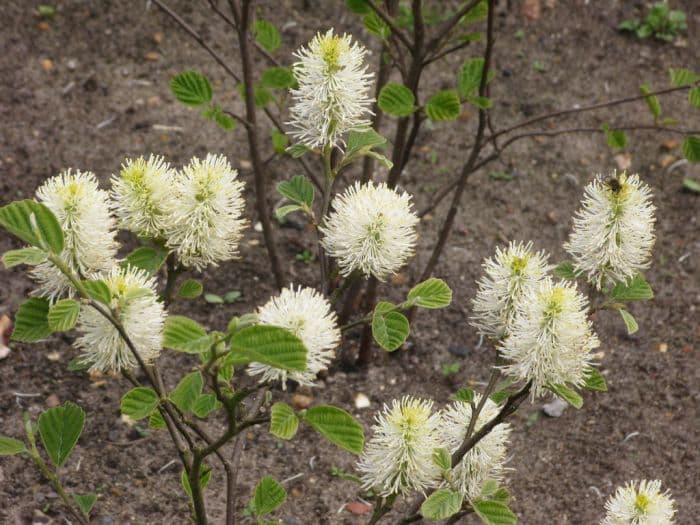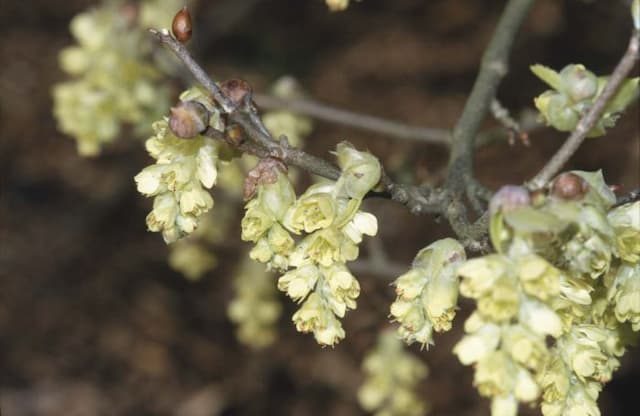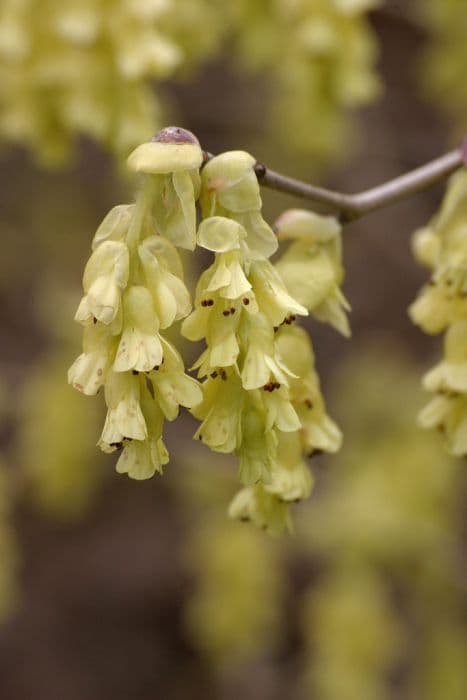Blue Shadow Witch Alder Fothergilla × intermedia 'Blue Shadow'

ABOUT
Blue Shadow is a striking ornamental shrub that captivates with its multiseason appeal. In spring, it is adorned with bottlebrush-like flowers that are pure white, giving a soft, fluffy appearance and contrasting beautifully with the foliage. The flowers are fragrant, adding a sweet, honey-like scent to the garden air. After the blooms fade, Blue Shadow's most distinguishing feature becomes prominent: its foliage. The leaves are a unique blue-green hue, providing a cooling effect in the landscape. This blue cast to the leaves is where Blue Shadow gets its name, and it remains attractive throughout the growing season. As autumn arrives, this shrub transforms once again. The leaves shift in color to a spectacular display of yellows, oranges, and reds, offering a fiery fall show that stands out in the garden. The texture of the foliage is smooth, and the leaves are broadly shaped, further enhancing the plant's visual impact. Despite not discussing dimensions, understand that Blue Shadow will be a substantial presence in a garden setting, contributing significantly to the overall design with its changing colors and notable characteristics. It is truly a versatile plant, offering ornamental value in various aspects from its flowers, to its unique blue-green summer foliage, and its vibrant autumn colors.
About this plant
 Names
NamesFamily
Hamamelidaceae
Synonyms
Blue Shadow Fothergilla, Blue Shadow Witch Alder
Common names
Fothergilla × intermedia 'Blue Shadow'.
 Toxicity
ToxicityTo humans
Blue Shadow, to the best of my knowledge and as of my last update, is not commonly known to be toxic to humans. There are no widely recognized symptoms of poisoning from ingesting or handling this plant since it is generally considered non-toxic.
To pets
Blue Shadow is not known to be toxic to pets. This plant does not commonly cause poisoning in animals, and there are no widely recognized symptoms associated with its ingestion by pets. It is generally considered non-toxic to both cats and dogs.
 Characteristics
CharacteristicsLife cycle
Perennials
Foliage type
Deciduous
Color of leaves
Blue-green
Flower color
White
Height
4-6 feet (1.2-1.8 meters)
Spread
4-6 feet (1.2-1.8 meters)
Plant type
Shrub
Hardiness zones
5
Native area
Southeastern United States
Benefits
 General Benefits
General Benefits- Attractive Flowers: The Fothergilla 'Blue Shadow' showcases beautiful white, brush-like flowers that have a pleasant fragrance in spring, adding aesthetic appeal to gardens.
- Striking Foliage: Exhibits blue-green leaves that provide distinctive coloration and seasonal interest.
- Exceptional Fall Color: Known for its spectacular fall foliage ranging from yellow to deep red and purple hues.
- Compact Size: With a moderate growth habit, this shrub is suitable for small gardens or limited spaces.
- Low Maintenance: Requires minimal pruning and is generally easy to care for once established.
- Deer Resistance: Less likely to be damaged by deer, making it suitable for areas where deer predation is a concern.
- Pest and Disease Resistance: Shows resistance to many common pests and diseases that affect other ornamentals.
- Native Plant Benefits: As a plant that is adaptive to North American climates, it can support local ecosystems and wildlife, including pollinators like bees.
- Versatility: Can be used in a variety of landscape designs, including borders, foundation plantings, and naturalized areas.
- Tolerant of Different Soils: Adaptable to a range of soil types, although it prefers acidic, well-drained soils.
 Medical Properties
Medical PropertiesThis plant is not used for medical purposes.
 Air-purifying Qualities
Air-purifying QualitiesThis plant is not specifically known for air purifying qualities.
 Other Uses
Other Uses- Fothergilla 'Blue Shadow' can be utilized as a natural dye source. The flowers and leaves may produce subtle colors when used in traditional fabric dyeing techniques.
- The dense growth habit of the plant offers shelter to small wildlife, such as birds and beneficial insects, who may nest or take refuge within its branches.
- It can be used in themed gardens, such as a blue-themed garden for its glaucous leaves that provide a unique blue-toned foliage among green plants.
- 'Blue Shadow' can be part of sensory gardens, where the texture of its leaves and the fragrance of its flowers can be appreciated for sensory stimulation.
- As a deciduous plant with significant seasonal changes, it can be used educationally in schools to teach children about the lifecycle of plants and seasonal variations in a temperate climate.
- This plant can be used in landscape art and photography, serving as a picturesque subject due to its striking fall colors and unique flower structures.
- In colder regions, Fothergilla 'Blue Shadow' can be used in winter gardens, where its interesting branch structure and form are attractive when dusted with snow or frost.
- Its robust nature allows it to be used in reclamation projects, helping to stabilize soil and support pollinator populations in disturbed areas.
- The plant's resistance to deer browsing makes it an ideal candidate for use in gardens in areas with high deer populations, where it can thrive without special protection.
- Because of its moderate size and attractive qualities, it is often used in horticultural competitions and shows, showcasing the gardening skills of the growers.
Interesting Facts
 Feng Shui
Feng ShuiThe Fothergilla is not used in Feng Shui practice.
 Zodiac Sign Compitability
Zodiac Sign CompitabilityThe Fothergilla is not used in astrology practice.
 Plant Symbolism
Plant Symbolism- Resilience: The Fothergilla 'Blue Shadow', being a hybrid, represents resilience through its ability to thrive in various conditions.
- Adaptability: Its tolerance for different soil types and environments symbolizes adaptability to life's challenges.
- Natural beauty: The plant is prized for its attractive blue-green foliage and white, fragrant flowers, symbolizing the appreciation of natural beauty.
- Transformation: 'Blue Shadow' undergoes a remarkable transformation in fall when its leaves change color, representing change and growth.
- Uniqueness: Its distinctive blue foliage sets it apart from other plants, symbolizing uniqueness and individuality.
 Water
WaterBlue Shadow Witch Alder should be watered thoroughly after planting and during its first growing season to ensure a strong root system. Once established, water it deeply at least once a week, allowing the soil to dry out slightly between waterings. During periods of drought or extreme heat, increase watering frequency to twice a week, providing about 1-2 gallons per watering for each medium-sized shrub. Avoid overhead watering to prevent fungal diseases and instead, water at the base of the plant.
 Light
LightBlue Shadow Witch Alder thrives best in full sun to partial shade. The ideal spot would receive morning sunlight and partial afternoon shade, especially in hotter climates. Avoid deep shade locations as this can result in fewer flowers and less vibrant fall foliage.
 Temperature
TemperatureBlue Shadow Witch Alder is hardy and can survive in temperatures as low as -10°F and as high as 100°F. However, the ideal growing temperatures for this plant range between 60°F and 80°F. Protecting the plant from extreme cold and heat can help ensure its health and longevity.
 Pruning
PruningPrune Blue Shadow Witch Alder in late winter or early spring before new growth begins. Remove any dead or damaged branches and shape the shrub as desired. Pruning promotes healthy growth and improves air circulation, which can reduce the risk of disease. Pruning every 2-3 years is typically sufficient to maintain its natural form and encourage flowering.
 Cleaning
CleaningAs needed
 Soil
SoilBlue Shadow Witch Alder prefers acidic, well-drained soil with high organic matter content. Aim for a soil pH between 5.0 and 6.5. A mix of peat moss, pine bark, and perlite in equal parts can create an ideal environment for this plant.
 Repotting
RepottingBlue Shadow Witch Alder, being a shrub, is usually planted outdoors and doesn't require repotting. In a garden setting, ensure it is planted in a location where it can grow without being moved.
 Humidity & Misting
Humidity & MistingBlue Shadow Witch Alder thrives in average outdoor humidity levels. It does not require any special humidity considerations beyond the natural outdoor environment.
 Suitable locations
Suitable locationsIndoor
Not suitable for indoor growth; needs full to partial sun.
Outdoor
Plant in acidic soil with sun to partial shade.
Hardiness zone
5-8 USDA
 Life cycle
Life cycleThe Fothergilla 'Blue Shadow', commonly known as Witch Alder, begins its cycle as a dormant seed that requires stratification to germinate. Upon spring arrival, germination occurs and seedlings emerge, developing into juvenile plants with distinctive blue-green foliage. As the Witch Alder matures, it enters the flowering stage in spring, characterized by fragrant, bottlebrush-like white blooms that precede leaf out. Throughout the growing season, 'Blue Shadow' experiences vegetative growth, with leaves transitioning to a striking mix of yellow, orange, and red in the fall before they are shed. The plant eventually reaches maturity, capable of sexual reproduction through flowers that attract pollinators, leading to seed set. The life cycle repeats as these seeds disperse, often requiring a period of cold dormancy before they can germinate and give rise to a new generation.
 Propogation
PropogationPropogation time
Early spring
Fothergilla 'Blue Shadow', commonly known as Blue Shadow witch alder, is typically propagated by softwood cuttings. The best time to propagate is in late spring to early summer when new growth is tender and green. To do so, a cutting of about 4 to 6 inches (10 to 15 cm) is taken from a healthy plant, making sure there are at least two to three nodes present. The lower leaves are removed, and the cut end may be dipped in rooting hormone to encourage root development. The cutting is then placed in a well-draining soil mix and kept in conditions with high humidity and indirect light until roots have formed, which usually takes a couple of weeks to a month. It is important to keep the soil consistently moist but not waterlogged to avoid rotting. Once rooted, the cuttings can be transferred to individual pots and allowed to grow on until they are ready to be planted out.









